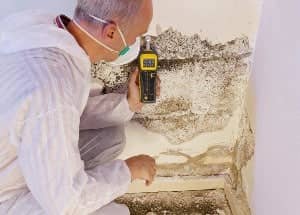When it comes to unwanted house guests, few things strike fear into a homeowner’s heart like the thought of termites. These tiny pests can cause serious damage to the structure of your home, leading to costly repairs and potentially even compromising the safety of your household. But how can you tell if you have a termite infestation? And more importantly, what can you do about it? In this comprehensive guide, we’ll explore the different types of termites, identify common signs of infestation, and offer tips for both inspection and prevention. So let’s roll up our sleeves and get to work – we’ve got some termites to catch!
Signs of Termite Infestation
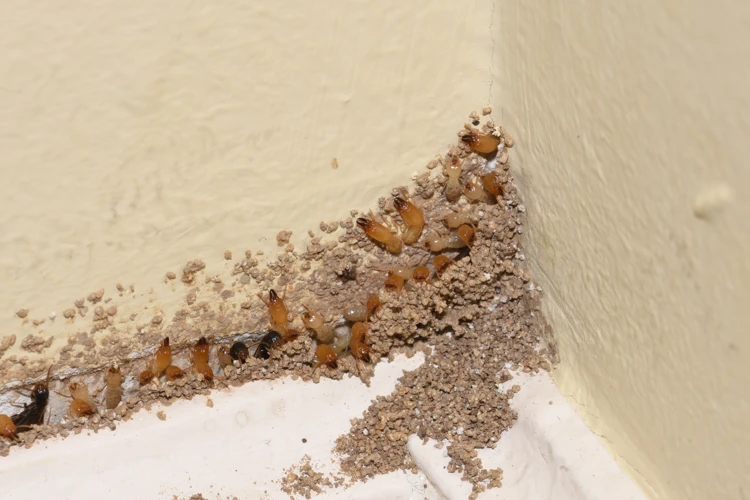
As a homeowner, it is important to be aware of the signs of termite infestation. These pests cause extensive damage to homes and can be difficult to detect. The first step in identifying a potential termite infestation is to look for mud tubes, swarmers, discarded wings, hollow wood, bite marks, noise, and frass. Each of these markers can indicate a different stage of termite activity, and early detection is key to preventing costly damage. In this section, we will take a closer look at each of these signs and what they mean for your home.
Mud Tubes
Mud tubes are one of the most common and recognizable signs of a termite infestation. These tubes are made from soil, wood, and termite saliva, and are used by termites to travel between their nests and their food source. Mud tubes can be found anywhere in the house where termites have infested, such as on the foundation, walls, and even on furniture.
Identification: Mud tubes are easy to identify, as they are about the width of a pencil and may be several feet in length. They are typically brown or tan in color, and feel hard and dry to the touch. If you notice any of these tubes in your home, it’s a strong indication that you have a termite infestation.
Causes: Mud tubes are created by subterranean termites, which are the most common type of termite found in the United States. These termites live in the soil and travel through mud tubes to access their food source. They are attracted to wood, and will infest any wooden structure in their path.
Prevention: To prevent mud tubes and termite infestations, it’s important to eliminate any sources of moisture in and around your home. Keep the gutters clean to avoid water buildup and check for any leaks in pipes or faucets. You should also remove any dead wood or tree stumps from your yard, as these can attract termites.
Removal: If you find mud tubes in your home, it’s important to act quickly to prevent further damage. Although you can remove them yourself using a scraper or putty knife, it’s best to contact a professional exterminator to assess the extent of the infestation and provide effective treatment.
Internal link to relevant article: Subterranean termite mating.
Swarmers
Swarmers are one of the most noticeable signs of a termite infestation. These are the winged termites that leave the colony in search of a new place to start a nest. They are often mistaken for flying ants but can be distinguished by their straight antennae, equal-sized wings, and broad waist. If you see a swarm of these bugs in or around your home, it is a strong indication of a termite infestation.
Swarmer season: Termite swarming season usually occurs during the spring and summer months when the weather is warm and humid. However, depending on the climate, swarming can happen throughout the year.
Where to find swarmers: Swarmers are attracted to light and are usually found around windows, light fixtures, and other sources of light. They can also be found on the ground, especially after a rain shower.
What do swarmers mean: Seeing swarmers does not necessarily mean that you have an active infestation in your home. However, it indicates that there is a termite colony nearby and that your home is at risk of an infestation. It is important to take preventative measures and have your home inspected by a professional to determine the extent of the infestation and develop a treatment plan.
How to prevent swarmer infestation: To prevent a swarmers’ invasion, it’s important to keep your home as dry and well-ventilated as possible. Fix any leaks or water damage immediately and have your home inspected for any signs of termite activity. Remove any dead trees or stumps in your yard and keep your firewood stored at least 20 feet away from your home. You can also consider a pre-treatment plan to protect your home against future infestations.
Swarmers are a clear indication of a termite infestation nearby and should be taken seriously. Taking preventative measures and having your home inspected by a professional is crucial in protecting your property from these destructive pests. For more information on the role of termites in the ecosystem, check out our article on Termites role ecosystem.
Discarded Wings
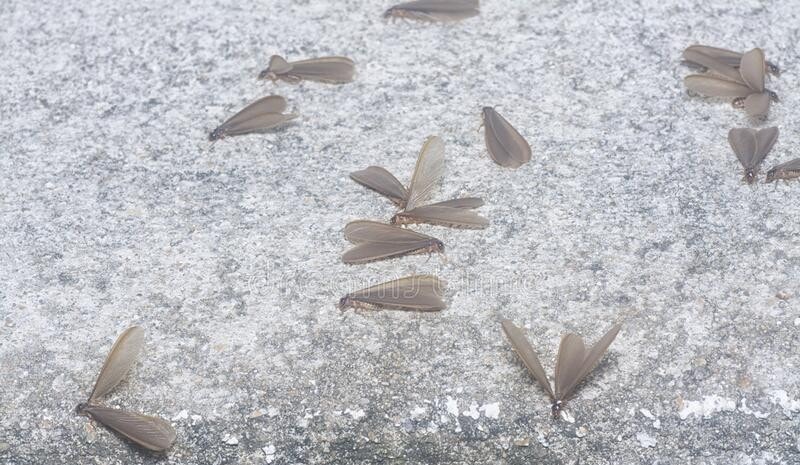
One of the most significant signs of a termite infestation is the presence of discarded wings. When termites establish a new colony, they send out swarmers or reproductive termites to mate and start a new nest. After they accomplish their mission, the swarmers shed their wings. The unusual sight of discarded wings in your home is a telltale sign that the termites have settled in.
If you notice discarded wings around your home, it’s essential to have a closer look to confirm that there is a termite infestation. Start by removing the wings cleanly and then examining them closely. Termite wings can vary slightly in size, but they are usually about the size of a grain of rice. They are also translucent or pale in color, which makes them easy to spot on dark surfaces such as floors.
It’s important to note that discarded wings are not necessarily a sign of an active infestation. Termites shed their wings once they have established a new colony, and it may be several months or even years before they start to cause significant damage to your home. Nonetheless, it’s critical to contact a professional termite inspector as soon as you spot discarded wings, as they will be able to determine if there is an infestation and provide you with a treatment plan.
If you’re unsure whether you have a termite infestation, contacting a professional inspector would be the safest course of action. Remember, early detection can help you avoid structural damage and save money on costly repairs.
Hollow Wood
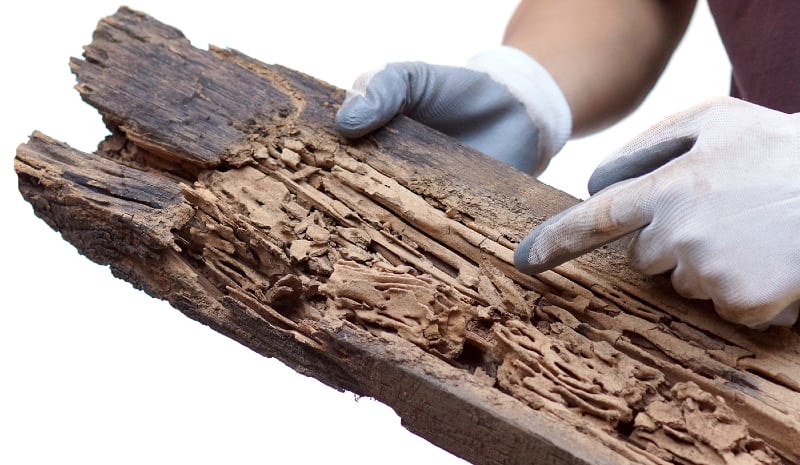
One of the most telling signs of a termite infestation is hollow wood. As termites eat through wood, they leave behind hollowed-out galleries and tunnels. This can weaken the wood and cause significant structural damage over time.
To check for hollow wood, tap on the surface of the wood with a hammer or screwdriver. If it makes a hollow sound or feels softer than normal, there may be termite damage. Additionally, look for small holes or cracks in the wood, as termites often create entry points this way.
It’s important to note that not all hollow wood is the result of termite activity. Other insects, such as carpenter ants, can also cause hollowing. Rot and decay can also leave wood feeling hollow. However, if you suspect termite damage, it’s important to have a professional inspection to determine the extent of the infestation.
What types of wood are most susceptible to termite damage?
Termites can infest any type of wood, but some species prefer certain types over others. For example, subterranean termites tend to prefer softer woods, while drywood termites prefer harder, dryer woods. Here are some types of wood that are particularly susceptible to termite damage:
| Cedar | Soft and porous, can attract termites and other pests |
| Redwood | Soft and lightweight, vulnerable to both subterranean and drywood termites |
| Pine | Softwood that is attractive to termites and other pests |
| Spruce | Softwood that is vulnerable to subterranean termites |
| Fir | Softwood that is susceptible to both subterranean and drywood termites |
How can you prevent termite damage to your wood?
Prevention is key when it comes to termite infestations. Here are some tips to help protect your wood from termites:
- Keep wood dry: Termites are attracted to moist environments, so make sure to keep your wood as dry as possible.
- Store firewood away from your home: If you keep firewood on your property, store it at least 20 feet away from your home
- Seal entry points: Seal up any cracks or crevices in your foundation to prevent termites from entering your home.
- Get regular inspections: Schedule regular termite inspections with a professional exterminator to catch any infestations early.
By taking these preventative measures and knowing the signs of a termite infestation, you can help protect your home from the devastating effects of termite damage.
Noise
Termites aren’t known for being particularly noisy insects, but on rare occasions, you may be able to hear them working in your walls. The sound of termites munching away on wood can often be mistaken for the sound of a quiet, tapping noise. This noise is often difficult to hear and recognize, but it is definitely worth investigating further if you hear it in your home.
Here are some noises that could indicate termite infestation:
- A sound similar to crinkling paper.
- A soft clicking sound coming from the walls.
- A rustling sound in the walls.
- A tapping or knocking sound, especially at night.
What should you do if you hear noises in your walls?
If you suspect that you have a termite infestation, it’s important to take action immediately. The longer you wait, the more damage these pests can cause to your home. Here are some steps you can take:
- Listen carefully to locate the source of the noise.
- Contact a professional pest control company to conduct an inspection.
- Follow the advice of the professionals to remove the termites and repair any damage done.
Don’t hesitate to contact a professional if you suspect there’s a termite infestation in your home. These pests can cause extensive damage in a short amount of time, and it’s important to act quickly to prevent further damage to your home.
Frass
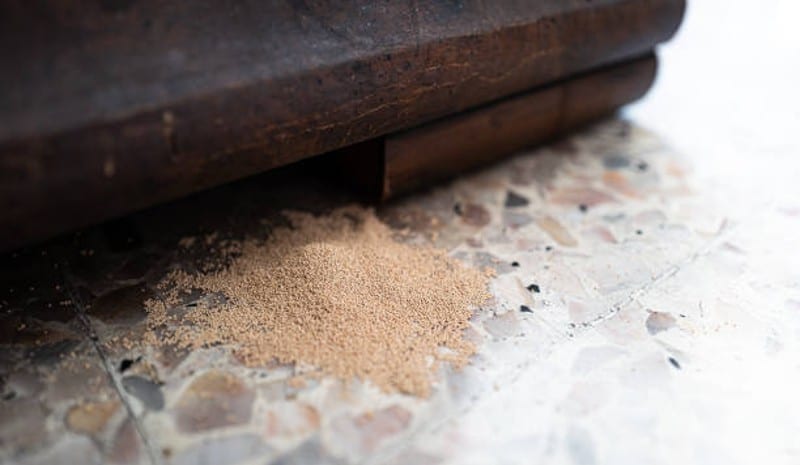
Frass is a term used by pest control professionals to describe termite excrement. It looks like a pile of small brown pellets or sawdust and is often found near the areas where termites are present. Being able to identify frass is an important part of identifying a termite infestation.
How to Identify Frass:
– Frass can often be found near cracks, crevices, and gaps in wood.
– It looks like small, hexagonal shaped pellets or grains of sawdust.
– Frass is often found in piles, as termites produce a large amount of excrement.
– It can be distinguished from sawdust by its size and shape, as well as the fact that it sticks together more than sawdust.
What Frass Tells You:
– The presence of frass typically means that there is an active termite infestation in or around your home.
– It can help you locate the source of the problem, as frass is often found in close proximity to termite activity.
– If frass is found inside the home, this can be an indication that termites have already done damage to the structure of the home.
– The size and amount of frass can also give you an idea of how serious the infestation is.
What to Do if You Find Frass:
– If you find frass in or around your home, it is important to contact a pest control professional immediately to assess the situation.
– Do not attempt to remove the frass yourself, as it could cause further damage to the affected areas.
– It is also important to continue to monitor the affected area for new frass, as this could indicate that the infestation is still active.
Frass may seem like a minor detail to some, but it can actually be a crucial factor in identifying a termite infestation. Being able to identify frass and understand what it means can help you take the necessary steps to eliminate the problem and protect your home.
Inspection and Prevention
As the saying goes, “prevention is better than cure.” This is especially true when it comes to termite infestation. Taking the necessary steps to prevent their entry into your home is important in avoiding costly repairs and potential damage. However, if you suspect that your home may already have a termite problem, it’s crucial to conduct a thorough inspection to identify the extent of the infestation. In this section, we’ll guide you through the inspection process and provide tips on prevention measures to help keep your home free from these destructive pests. Let’s take a closer look.
Inspecting your Home
Performing regular inspections of your home is crucial in preventing termite infestations. By catching termite activity early, you can save yourself the trouble and expense of a full-blown infestation. Here are some key areas to inspect in and around your home:
| Area of Inspection | Description |
|---|---|
| Foundation | Inspect the foundation and look for mud tubes or damaged wood. Termites often enter homes through the foundation and work their way up. |
| Attic | Check for termite droppings, which can look like sawdust, as well as any signs of live termites. |
| Basement or crawl space | Look for any signs of termite activity, such as mud tubes, damaged wood, or termite droppings. |
| Exterior walls | Inspect the outside of your home for mud tubes or wood damage, paying close attention to areas where wood meets soil. |
| Windows and doors | Look for discarded wings or other signs of swarmers, as well as mud tubes or termite droppings. |
| Roof | Check for any signs of termite damage, such as sagging or cracked rooflines. |
Remember: Even if you don’t see any signs of termite activity during your inspections, it’s still a good idea to have regular professional inspections to make sure you’re not missing anything. Prevention is always better than having to deal with an infestation later on.
Prevention Tips
One of the most effective ways to prevent termite infestations is to make sure that your home is not an attractive target for these pests. Here are some tips to prevent termites from entering your home:
| Tip | Description |
|---|---|
| Reduce moisture | Termites thrive in moist environments, so repairing any leaks in your home’s plumbing, ventilation or air conditioning systems, and ensuring that there is no standing water near your home’s foundation can help prevent an infestation. |
| Store firewood properly | Termite infestations often start from firewood stored too close to the home. Keep firewood away from your home and elevated off the ground. |
| Seal cracks and crevices | Termites can enter your home through small openings in the foundation or walls. Seal up any gaps or crevices with caulking or other sealants. |
| Trim trees and vegetation | Termites often use branches as bridges to enter your home. Keep tree branches trimmed at least 6 feet away from your home and remove any debris or deadwood that may provide a food source for termites. |
| Use treated wood | Untreated wood is vulnerable to termite damage. When building or renovating, use pressure-treated wood that contains chemicals to deter termite infestations. |
| Get regular inspections | Professional pest control companies can conduct regular inspections of your home for signs of termite activity, and take any necessary preventative actions before an infestation starts. |
By following these prevention tips, you can reduce the risk of a termite infestation and protect your home from costly damage.
Conclusion
In conclusion, identifying the signs of termite infestation is crucial for protecting your home from the damaging effects of these destructive pests. It’s important to understand the different types of termites and the behaviors that are specific to each species. Keep an eye out for mud tubes, swarmers, discarded wings, hollow wood, bite marks, noise, and frass — these are common indicators of termite activity in and around your home.
If you do suspect a termite infestation, it’s essential to take action as soon as possible. Don’t wait until the damage is noticeable. Quick action can limit the damage and keep the infestation from spreading. Regular inspections of your home can also help prevent termite problems before they start.
There are several steps you can take to reduce the risk of termite infestation, such as minimizing moisture around your home, sealing cracks in your foundation, and reducing wood-to-soil contact. However, professional inspection and treatment may be necessary to fully protect your home from termites. An experienced pest control professional can help identify any termite activity in your home, and create a customized treatment plan to eliminate the infestation and protect your property.
In summary, by understanding the signs of termite infestation and taking the necessary steps to prevent and address any potential issues, you can protect your home and avoid costly damage. Don’t hesitate to seek professional help if you suspect a termite infestation — the sooner you act, the better for your property and family’s health.
Frequently Asked Questions
What is the best way to prevent termite infestation?
The best way to prevent termite infestation is to eliminate moisture sources and seal all entry points where termites can enter.
How long does a termite infestation typically go unnoticed?
Termite infestations can go unnoticed for several years, during which time extensive damage can occur.
Can termites be eradicated without professional treatment?
No, professional treatment is often necessary to effectively eradicate a termite infestation.
How quickly can termites cause damage to a home?
Within a few months, termites can cause significant damage to a home.
What are some common signs of termite infestation?
Some common signs of termite infestation include mud tubes, swarmers, discarded wings, hollow wood, bite marks, noise, and frass.
What should I do if I suspect a termite infestation?
If you suspect a termite infestation, you should contact a professional exterminator immediately to schedule an inspection and treatment.
Can termites fly?
Yes, termites known as swarmers have wings and can fly short distances in search of a new place to establish a colony.
Are termite inspections necessary even if I don’t see any signs of infestation?
Yes, termite inspections are recommended on a regular basis, even if no signs of infestation are present, to catch any potential problems before they become serious.
Will my homeowner’s insurance policy cover termite damage?
No, most homeowner’s insurance policies specifically exclude termite damage from coverage.
What is the typical cost of professional termite treatment?
The cost of professional termite treatment varies depending on the severity of the infestation and the size of the home, but can range from several hundred to several thousand dollars.

